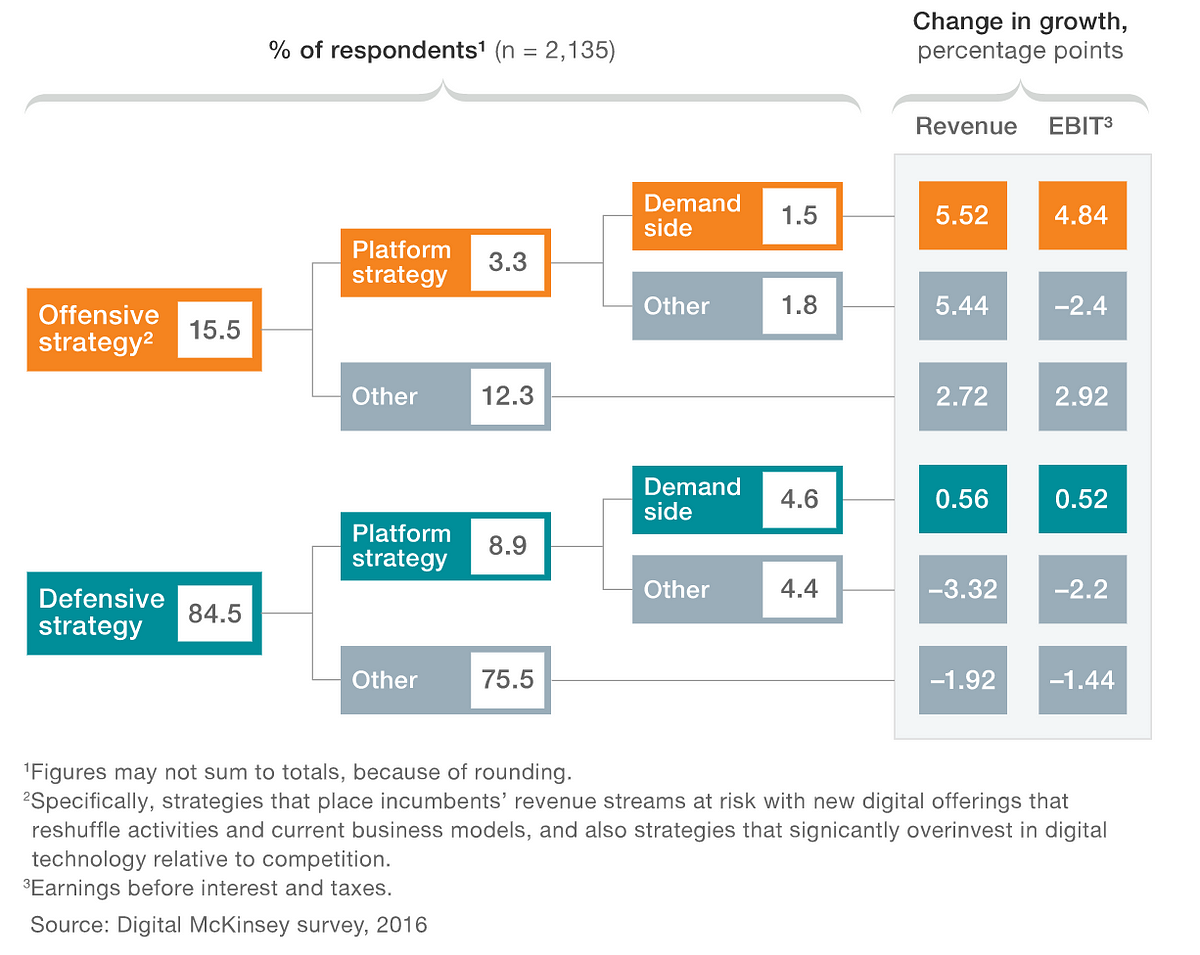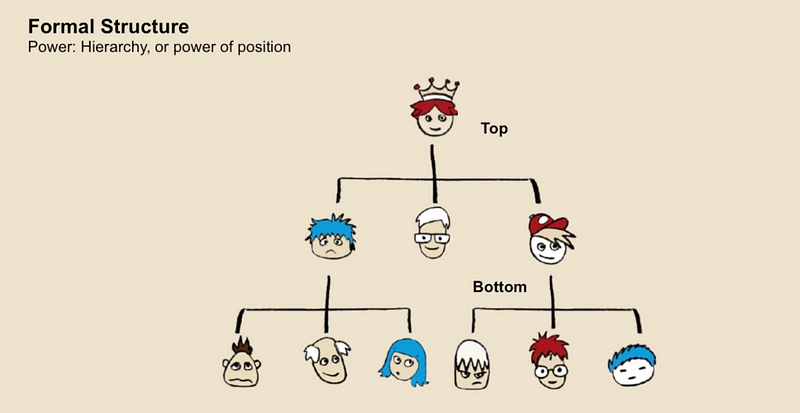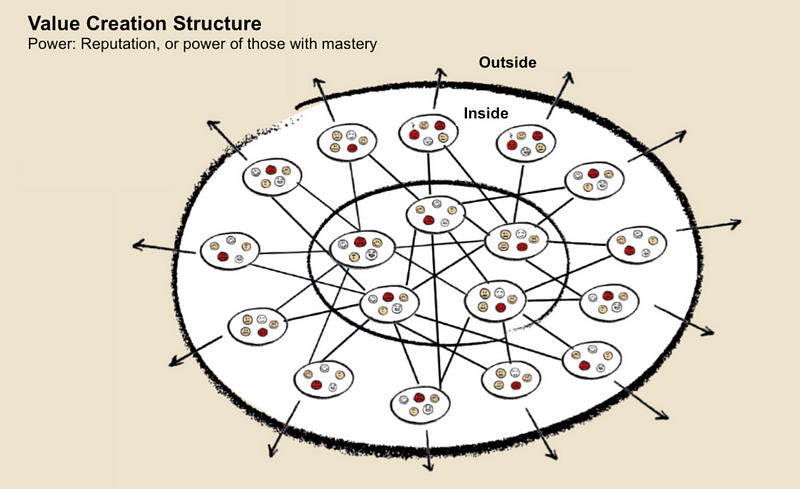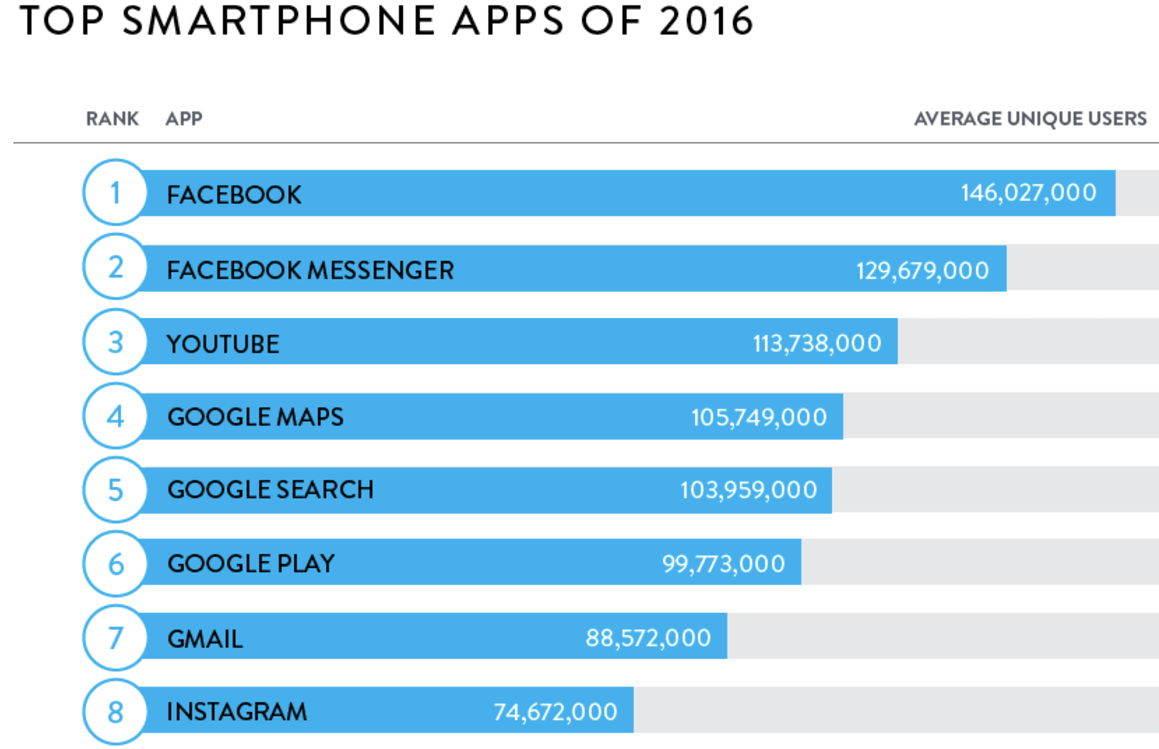By Simone Cicero and originally published at platformdesigntoolkit.com
Understanding the real implications of growing potential at the edge of Organizations, Institutions and Society.

It can surely be said that, during 2017, the concepts of platforms and ecosystems made their way to the core of the discussion on business and society transformation. Despite the platform topic being “hot” for a few years, my feeling is that we are eventually now understanding what are the deep implications of an ever increasing technology pervasivity, and of the related explosion of potential at the edge of systems. We’re now more conscious of how these trends ask us to re-imagine the very concept of what an organization is and how it works, to rethink our public institutions embracing openness, to figure out how every single individual needs to behave to find new opportunities and respond to ever increasing challenges for growth and transformation, in the VUCA world.
This post is a collection of some of the most significant reads of last year on the topics of platforms and ecosystems, organized in a way that can hopefully lead the reader to the same insights these reads led us to. It also contains a related selection of our best post of 2017 at Stories of Platform Design, the fortnightly blog of Platform Design Toolkit team.
Though based on 2016 data, August’s “New evidence for the power of digital platforms”, from McKinsey reported that the 15.5% of incumbents, that have effectively been elaborating offensive platform strategies, have reported extremely better results.

Ecosystem Power plays have also been mentioned by Accenture’s 2017 Technology Vision as one of 5 key trends to shape the future of business; the report speaks of companies that “increasingly integrate their core business functionalities with third parties and their platforms”, and of relationships that need to be leveraged to build a new role for companies in interaction with their ecosystems. We particularly share this vision and we’ve been able to share our ideas recently about how companies should design their ecosystem strategies (including APIs, microservices and platform moves) to allow disobedience and discover what their role should be in the future-present.
The Future of Businesses and Organizations speaks Platforms
To highlight the huge impact that the adoption of open, boundaryless modes of production might have on organizations, another interesting 2017 report — from Bain — dedicated to exploring the shape of The Firm of the Future envisioned that, in ten years, most of the work in organizations will be performed by self-managed teams that “will blend internal and external resources to provide the right skills as needed” where “employees will have no permanent bosses […] and coaching and feedback will be real-time and continuous”.
The depth of opportunities and challenges for organizations that want and need to embrace this new way of thinking, is extremely well captured in Paul Hobcraft’s encompassing read “Adjusting to the Changing Landscape of Ecosystems” stating clearly how “the traditional confines of market boundaries are clearly breaking down” and how this is “driving a radically different environment to manage within”.
All the links you find in this post have been previously shared in our fortnightly newsletter. Take the opportunity to register and be informed timely of great curated reads, new toolkit releases, and early and discounted access to events and training opportunities accessible to our community of 1000+ registered readers.
A New kind of Organizations for a new Context
Is easy to understand how our current organizational models are not up to the challenge: how can we achieve the full potential of platform thinking with industrial, bureaucratic organizations? We simply can’t.
Are Platforms essentially the “bureaucracies for the networked age” as Greg Satell said once?
From the early 70s, Conway’s Law has been used as a lens to redesign organizations that want to create outputs in line with the progress of enabling technologies. But, if it’s true that “any organization that designs a system will inevitably produce a design whose structure is a copy of the organization’s communication structure”, it’s also true that un-bundling organizations to make them able to compete in an un-bundled world — increasingly made of small teams and small entities interacting — might pose unprecedented challenges in terms of organizational loyalty, strategic integrity and measurable outcomes.
By splitting organizations in small parts we might generate a feeling of “otherness” and give room to competing behaviors between units, teams and individuals, often loosing the big picture. In this great post from Fortune, Pivotal’s Josh McKenty gave a great explanation — reported by Dan Woods — of how: “Platforms can allow businesses to cultivate a sense of “we’re all in this together”, […being the platform…] a neutral zone where everyone can come as they are, express what they really think, and therefore promote a type of honesty and collaboration that breaks down the barriers imposed by Conway’s Law for the benefit of the organization.”
If you’re curious of our take on how organizations must be un-bundled for the platform age read:
Another enlightening read that came out this year, as a powerful lens for understanding how big the organizational challenges are, for those that want to fully embrace the possibilities of boundaryless thinking, was Niels Pflaeging’s “Org Physics: How a triad of structures allows companies to absorb complexity”.



It was by looking at the Formal-Informal-Value Creation triad of structures that we have been able to realize better how platform thinking is just a way to focus on how your organization enables repetable, scalable and borderless value creation patterns in ecosystems, that we consolidated in our series on the platform organization.
A changing context: the Digital Transformation of the market and the role of Platforms
If there’s one read from this year that you really need to care about, to better frame how this emerging model is fitting with larger market transformations, this is John Hagel’s “Big Shift in Platform Business Models” coupled with the following Exploring Business Types and Business Models, issues shortly after as a complementary clarification. These two reads will help you frame where platforms are supposed to operate in digital markets, and when it makes sense for you to join or build a market shaping strategy.
As a further exploration, this series on digital transformation by lisagansky is also a too important read to not be featured: enjoy part 1, part 2 and part 3 (my preferred one), explaining how future is a moving target, that you can most likely chase with …platform strategies.

200 individuals have been trained in our public masterclasses in 2017, reporting radical “changes in perception” “enlightenment” and “mindset shift”. Join us for the upcoming 2 Day Masterclass in Paris, few Early Birds available until end of December.
Platform strategies to Innovate Business
Despite the organizational challenges abound, and business strategy innovation is a hard challenge, platform strategies are asset-light and show the potential to saturate niches, and monopolize markets. This characteristics make platform strategies a powerful tool to explore and create new sustainable business cores, as we explained in our post about “How to use Platforms to Explore new Business Ideas for your Company”.
A series of great post this year have been exploring recurring pattern at product-to-platform transition. Harvard Business Review’s “Is There a Platform in Your Product?” and “You Don’t Need to Be a Silicon Valley Startup to Have a Network-Based Strategy” can seriously help you demystify the complexity of a platform move, re-conducting it to an essential, basic and modern strategy that is at hand of many companies, essentially being more reliant on intelligence, experimentation and design, than on upfront capital.
Of course, if you think that platform strategies are the “hammer”, the risk is to look at everything as a…nail: Greg Satell in October took the chance to explain how you don’t want to be a victim of the “Platform Fallacy”. The point is that “value creation is simply not something you can run a successful business without”, and therefore is not enough to use the P word: you actually need to investigate the deep value creation processes, beyond connecting multiple sides on a market and hope for network effects to make a difference.
A growing practice of Platforms and Marketplaces Design
As our loyal users know we’re approaching the challenge of designing boundaryless strategies starting from the “tooling” perspective. As we explained in our “Creating Design tools for the Age of Networks”,we firmly believe that there’s not a one-size-fits-all approach, and therefore we actively explore how other design approaches, tools and considerations can complement Platform Design Toolkit.
During 2017, we’ve been focusing on complementing the original set of Canvases in #PDToolkit by extending it in two key directions: by adding a User Research dedicated tool, the Entity Portrait, and by evolving the tradition of Lean Startup and Customer Development into the age of multi-sided, platform powered, ecosystem age with the release of Lean Ecosystem Development.
To look up a key example on how to use these new tools, one could look into our Design For Ecosystem series, and especially to “Design For Ecosystems: Discovering Potential and Testing Assumptions”.
To point out a series of further reads that we’ve found crucial and interesting this year, on the aspects of platform design and evolution, I want to mention these two essential reads from ShareTribe’s Marketplace Academy: How to design the booking flow of your service marketplace and Node saturation as a strategy for marketplaces. The publication has been producing great pieces, one after another and is definitely a channel you’ll want to follow, if platforms are your thing.
At least other three key reads on topics related to the design and growth of platforms — with a focus on the marketplace aspect — are worth mentioning. “Why Onboarding is the Most Crucial Part of Your Growth Strategy” from Casey Winters on Greylock Perspectives blog is an essential read on one of the key aspects of any digital service; “How Digital Platforms Work” from Ameet Ranadive presents an excellent insights on price formation and its relationship with supply and demand. Finally, “Marketplace liquidity” is probably one of the best primer around on another key aspect of marketplace development.
Last but not least, still on the topic of improving your capability to design and evolve powerful shaping strategies, it’s impossible not to mention some reads regarding the greatest of the potential breakthrough in the design of complex large scale systems: Crypto Tokens.
I had the chance of explaining why I firmly believe that tokens are opening new doors to platform thinkers in my earlier “Blockchain Powered Platforms” but I want to mention explicitly these two essential read on the topic: “On Token Value” by Nick Tomaino, that features a super useful token taxonomy, and “Crypto Tokens: A Breakthrough in Open Network Design” that really helped me starting to scratch the surface of the enormous potential that this technology is bringing to platform thinkers.
The Impact of Platforms
The particular nature of platforms have been even more under scrutiny in 2017 than in the past years, and many people really started to understand better the phenomenon, the problems and the potential solutions, beyond ideological rants. The fact that “Ours to Hack and to Own” is one of the best books of 2017 according to Wired, says pretty much everything on the growing awareness of the risks of power concentration.
The problem that I always had with critique focused movements is that those are, exactly, mostly about criticizing. Despite this, I’ve found interesting to read a few comments this year such as “The dark side of platform monopoly” and “How Digital Platforms Increase Inequality” both from Sangeet Paul Choudary (definitely not a luddist that has voiced some concerns), and “Tech and the Fake Market tactic” by Anil Dash: these posts are expressing substantiated concerns about the concentration of power in aggregated monopolies and are worth our attention, as designers before than regulators.
The PlatformCoop movement — born a few years ago with these concerns in mind, plus some extra anti-silicon valley ideology — looks maturing into a, somehow, less destructive conversation (here is possible to watch all the talks from the third edition of the conference): this post shared by Trebor Scholz coming back from Tenerife Colaborativa — where I had myself the chance to give a short masterclass — might be useful to those that want to understand more of the progress being made.
There’s no doubt, by the way, that the internet looks different after a decade of platform dominance: a worried opinion have been voiced by no-less than Tim Berners-Lee this year, proclaiming “The End of the Internet Startup”, talking about a internet of giant players that are cannibalizing every opportunity at hand, growing and squeezing the rest of the internet in the middle.
A substantiated analysis that — somehow — confirms Lee’s picture on the state of the net, can be found in the, now legendary, Mary Meeker’s Internet Trends Report that we’ve been able to comment briefly in May in our “The future of Platforms & Markets: reading Meeker’s Internet Trends ‘17”.

This year’s report depicts a strong platform consolidation trend, the increasing monopolization of advertising, and a world where 10 out of 10 of the most used smartphone applications (the place where you spend most of your time and attention) are owned by Facebook and Google and distributed by Google and Apple. Scary enough.
Wrapping Up
Some Extra reads we’ve found interesting and some other posts from us:
On Vertical Industries, Finance:
- Platform Banking Taxonomy — Available at: https://www.linkedin.com/pulse/platform-banking-taxonomy-pascal-bouvier-cfa/
- Is Open Banking an Opportunity, a Threat — or Both?: An Interview with Pietro Sella, CEO, Banca Sella Group — Available at: https://www.bcg.com/publications/2017/technology-digital-is-open-banking-an-opportunity-threat-both-interview-pietro-sella.aspx
On Vertical Industries, NGOs:
- Platforming — what can NGOs learn from AirBnB and Amazon? — Available at: http://wvi.org/disaster-management/blogpost/platforming-what-can-ngos-learn-airbnb-and-amazon
On Public Services as Platforms, with a focus on Healthcare:
- It’s the business model, stupid — three steps to transform UK public services — Available at: http://www.computerweekly.com/opinion/Its-the-business-model-stupid-three-steps-to-transform-UK-public-services
- Healthcare urgently needs a Copernican Revolution — Available at: https://medcitynews.com/2017/04/healthcare-urgently-needs-copernican-revolution/?rf=1
Related to this, read about our experience helping St. Cuthbert’s hospice in UK:
On Supply Chains as Platforms:
- The future of supply chains as networked ecosystems — Available at: http://platformed.info/the-future-of-supply-chains-as-networked-ecosystems/
On topics strictly related to Platforms, Network Effects and Ecosystems:
- Learning effects, network effects, and runaway leaders. — Available at: https://techcrunch.com/2017/09/21/learning-effects-network-effects-and-runaway-leaders
- The Network Effects Map — Available at: https://medium.com/@nfx/the-network-effects-map-nfx-case-study-uber-49f82e0c4664
Research and Event reports:
- Platforms and Ecosystems — a full report from Technology Innovation Management Review — Available at: http://timreview.ca/article/1101
- Boston’s Platform Summit Report — Available at: http://ide.mit.edu/sites/default/files/2017-MIT-Platform-Summit-Report.pdf
Republished with permission of the author.
Featured Image/graphic link added by Enlivening Edge Magazine




